The ‘Big Australia’ boosters at the Grattan Institute have released another Panglossian report on Australia’s immigration program – essentially 154 shiny pages accentuating the positives and eliminating the negatives.
Of particular note, Grattan spruiks that “skilled migrants in particular tend to be younger, higher-skilled, and earn higher incomes than the typical Australian”, only to later admit that “the median (i.e. typical) wages for TSS [temporary skills shortage] visa-holders in Australia is $75,000 today, less than the median full-time wage in Australia of $82,000 a year” and that “a growing share of TSS visa-holders are employed on low wages with one quarter earning less than $62,000 a year”.
The below Grattan chart also shows that migrants tend to earn less than those born in Australia across age groups of 25-34 and above. This is especially true of migrants that arrived less than 10 years ago:
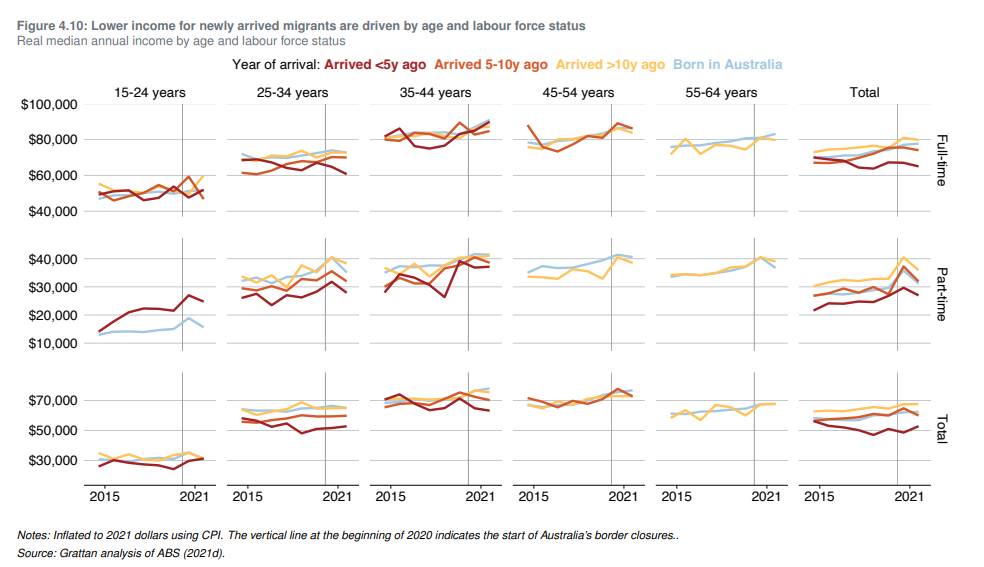
Grattan then tries to argue that the collapse in immigration over the pandemic has not benefitted Australian workers:
Many Australians worry that migrants are going to take jobs or suppress their wages. But there is limited evidence that immigrants ‘take jobs’ or materially reduce the incomes of Australians, at least in aggregate…
The closure of Australia’s international border in response to the pandemic, together with the rapid recovery in Australia’s labour market, have led some commentators to conclude that border closures are the main driver of Australia’s recent strong labour market…
But fewer migrants largely reduced both the demand for and supply of labour in Australia, and is likely to have had little impact on the employment prospects and wages of Australian workers at the aggregate. Recent Grattan Institute analysis showed that unprecedented fiscal and monetary stimulus, rather than closed borders, is the main driver of Australia’s record-low unemployment rate.
MB comprehensively destroyed (here and here) Grattan’s shoddy analysis claiming “that unprecedented fiscal and monetary stimulus, rather than closed borders, is the main driver of Australia’s record-low unemployment rate”. If Grattan’s claim was true, then how have Australia’s unemployment and underemployment rates collapsed to a multi-generational lows:
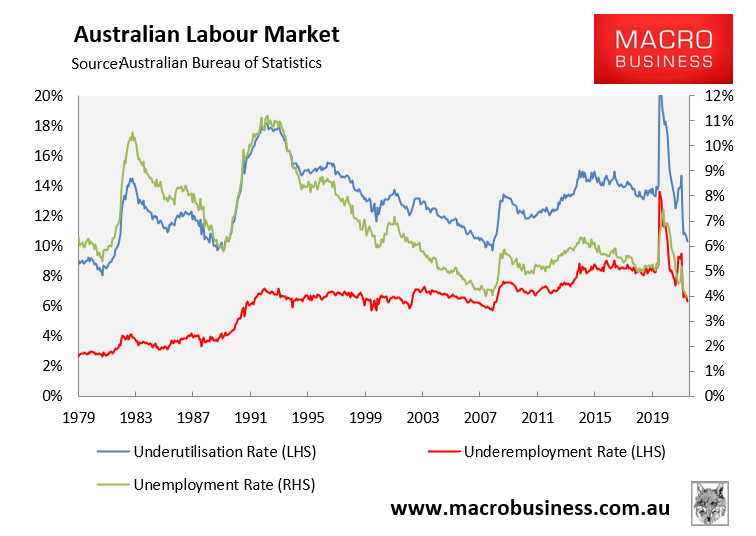
When employment growth has lagged the pre-COVID trend?
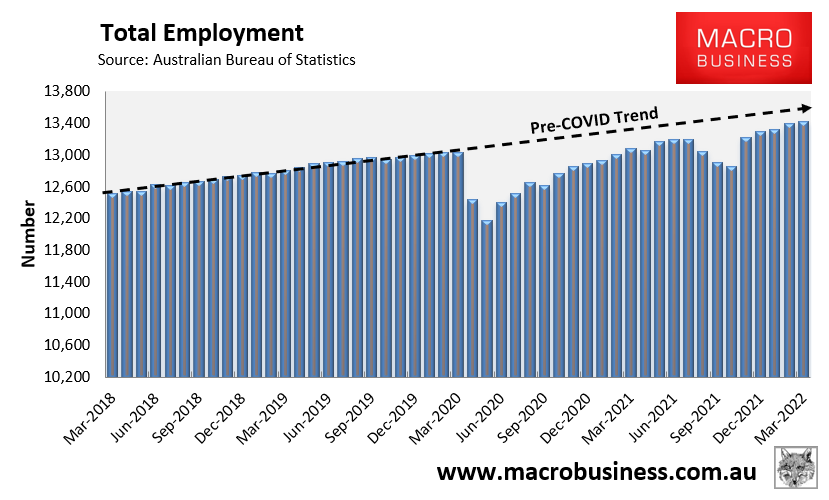
And both the labour force participation rate and employment-to-population ratio are at all-time highs?
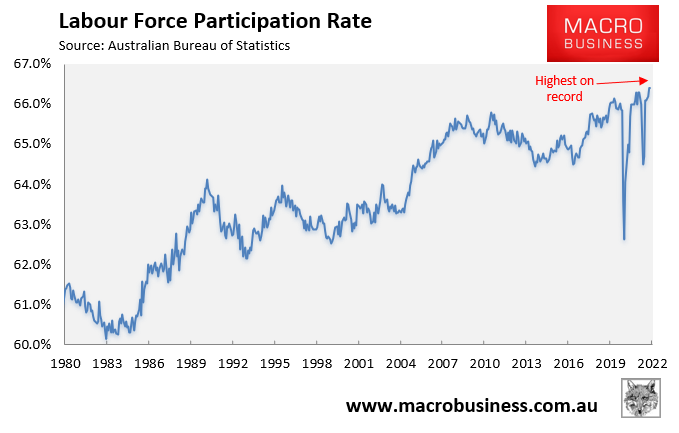
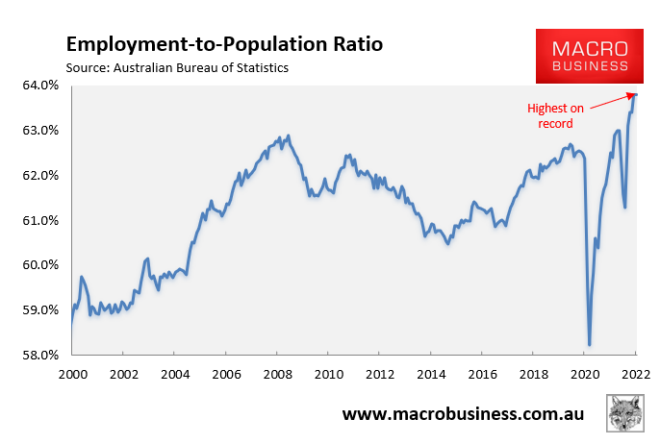
The answer is obvious to all but the immigration shills at the Grattan Institute: Australia’s labour supply has stagnated on the back of the collapse in immigration, meaning that jobs have gone to unemployed Australians rather than migrants.
As shown in the next chart, Australia’s civilian population aged over 16 has gone from growing strongly (circa 25,000 people a month pre-pandemic) to growing only slowly:
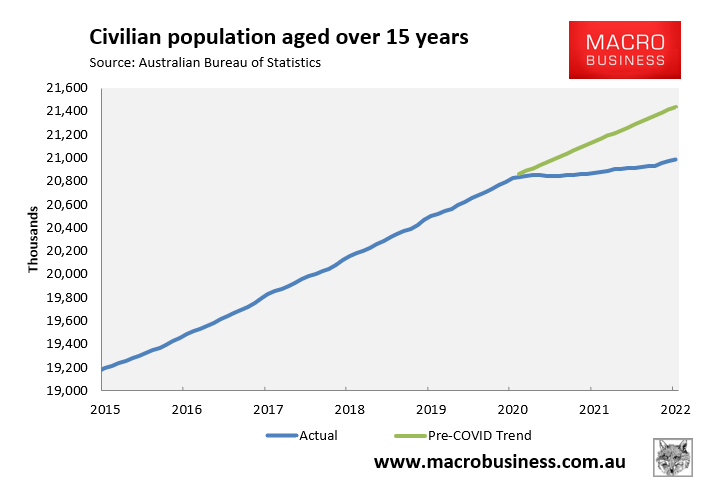
Had immigration continued at its pre-COVID level, Australia’s civilian population aged over 16 would be roughly 450,000 larger than it is currently. In turn, both unemployment and underemployment would be significantly higher and the employment to population ratio would be much lower (due to an increase in the denominator).
Don’t just take my word for it. Professor Bill Mitchell’s – Chair in Economics and Director of the Centre of Full Employment and Equity (CofFEE), an official research centre at the University of Newcastle – estimates that Australia’s unemployment rate would be 2.7% higher if immigration continued at its pre-COVID trend:

But wait, Grattan’s gaslighting doesn’t stop there. It also falsely claims that Australia’s capital stock has kept pace with the explosion in our population from mass immigration:
Some worry that Australia’s comparatively high levels of migration reduce the amount of capital, the equipment, buildings, land, and other assets that each Australian worker has to work with, thereby reducing their wages. Yet capital investment appears to adjust quickly to, and often in advance of, migration that adds to the labour supply. Australia is a small, open economy with good access to global capital markets. Australia’s capital stock per person has risen rapidly over time. Australia’s current immigrant intake is planned ahead and, despite some yearly fluctuations, relatively consistent.
Of all the heroic claims made it its report, this one is arguably the most egregious. It flies in the face of the lived experience of Australians in the 15 years prior the pandemic, whereby they witnessed all forms of infrastructure – both economic and social – become crush loaded under the never ending immigration deluge.
Grattan’s statement also contradicts its incessant complaints about housing shortages and infrastructure bottlenecks, as well as Australia’s declining productivity as immigration boomed.
If migrants are so much more productive than locals, and “Australia’s capital stock per person has risen rapidly over time… [and] appears to adjust quickly to, and often in advance of, migration”, then why has Australia’s productivity performance deteriorated so badly?
Finally, Grattan’s love affair with ‘Big Australia’ immigration highlights its broader contradictions across a number of policy areas, including:
- Grattan laments Australia’s poor progress at meeting its ‘net zero’ emisions reduction goals, but contradictorily supports Australia growing its population by 50% over the next 40 years, which will necessarily drive up emissions and wreck the natural environment.
- Grattan continually bemoans Australia’s infrastructure waste, but ignores the extreme immigration driving the demand for expensive new infrastructure.
- Grattan continually laments Australia’s lack of housing supply and poor planning, but contradictorily supports the mass immigration driving the problems.
- Grattan laments the lack of social housing, but supports the mass immigration driven population growth driving this shortfall.
To put it bluntly, the Grattan Institute suffers from a chronic case of cognitive dissonance surrounding immigration.
Grattan’s undying support for mass immigration directly contradicts its other policy goals.
Of course, advocating lower immigration would aggravate Grattan’s big business financial backers, so it wouldn’t want to do that, would it?

